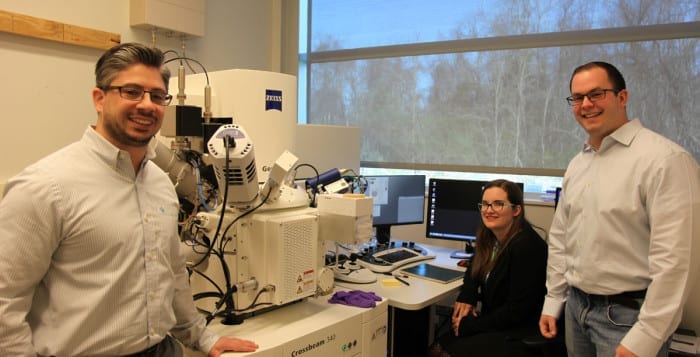SBU’s Trelewicz wins $500,000 NSF Early Career Award

Jason Trelewicz has had a productive return to Stony Brook University. A graduate of Mount Sinai High School, Trelewicz received a bachelor’s degree in engineering from SBU in 2004. After that, he earned a Ph.D. in materials science and engineering from the Massachusetts Institute of Technology and then worked at St. James-based MesoScribe Technologies. He became an assistant professor of materials science and engineering at Stony Brook in 2012.
Recently, Trelewicz won a National Science Foundation Faculty Early Career Development Award, which provides $500,000 over a five-year period. Trelewicz’s research focuses on transforming applications of high-strength metals.
Trelewicz is “tremendously talented. He goes after bold initiatives,” said Fotis Sotiropoulos, the dean of the College of Engineering and Applied Sciences at SBU. “He is also actively involved in pushing forward some of the high-performance computing initiatives we have as a part of the Institute for Advanced Computational Science. He has a terrific career ahead of him.”
Trelewicz’s scientific efforts center around amorphous metals. He uses computational modeling and conducts experiments on metals that have a disordered atomic structure that is similar to glass and, as a result, are called metallic glasses.
The metals he works with are different from everyday metals because they do not have a regular atomic structure. The atoms that make up amorphous metals or metallic glasses are in a highly disordered state.
The amorphous metals “require a lot more force or stress to initiate permanent deformation,” Trelewicz said, which makes them higher strength. Instead of deforming like crystalline metals, they become brittle. The likelihood of these types of metals developing a brittle failure is one of two problems with amorphous metals, he said. The other is that it’s difficult to make these metals in large parts like a sheet.
In his work, Trelewicz hopes to overcome these difficulties. He said amorphous metals have applications in industries ranging from automotive to aerospace to consumer electronics.
As a part of this award, Trelewicz is expected to use these funds to further his teaching efforts. “I’m extremely passionate about introducing students to the vast field of materials science and engineering,” he explained.
Jeff Brogan, the CEO of MesoScribe, hired Trelewicz and witnessed his work habits. In a recent email, he described Trelewicz as “very organized and an excellent project manager.” Brogan called Trelewicz a “valuable member of [the] proposal writing team” and suggested he “helped secure a number” of government contracts.
While he was at MesoScribe, Trelewicz was involved in developing new sensors to measure temperature, strain and other properties of interest to MesoScribe’s customers, Brogan said. “His efforts on ice detection and ice mitigation led to a patent application which was approved and is soon to be issued,” Brogan said.

Trelewicz initially became interested in amorphous metals through golf. An enthusiast of the sport, Trelewicz remembers reading about how the golf club industry used these types of metals on the face of golf clubs. Their elastic properties enabled more energy to be transferred to the ball rather than be absorbed as elastic strain energy.
Trelewicz wants to develop new high-strength materials that resist permanent deformation and that are not brittle. He will use simulations that model atomic interactions in a material to build an understanding of deformation physics, which he plans to use to design a more resilient alloy. He hopes to distribute defection initiation and propagation to inhibit crack formation.
Trelewicz said he has been told by a number of people that he respects that it is going to be difficult to make these materials with the proposed manufacturing process. He is encouraged by his understanding of the deformation of metallic glasses and believes the process is capable of creating structural inhomogeneities that will help him achieve his goals.
When he was looking to return to academia, Trelewicz set his sights on Stony Brook, where he was pleased with all the changes the university has gone through since he left in 2004.
“It’s astounding how the campus has evolved,” Trelewicz said. He appreciates the investment the university has made in its faculty members and in students adding, “I feel like I’m part of something huge.”
Trelewicz and his wife Lauren, who teaches global studies at Earl L. Vandermeulen High School in Port Jefferson, live in Miller Place and are expecting their second daughter in May. The couple, who went to the junior and senior prom when they were in high school, appreciate being close to both sets of parents and to the Long Island coastline, where they enjoy summer power boat trips to Orient Point and across the Long Island Sound. “Our family is a very big part of our lives, as is boating in the summers,” Trelewicz said.
As for his work, he relishes interactions with his colleagues. “Passionate discussions are what make being a scientist so exciting. I particularly enjoy collaborating with colleagues across academic, national labs and industry as I think it adds new dimensions to the thought process and promotes innovative ideas.”






